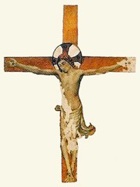

The art gallery of Montefalco is housed in the ex-church of San Francesco: works that survive in situ are described in the page “ Works in situ in San Francesco”. This page describes other works in the Pinacoteca.
Christus Patiens (late 13th century)
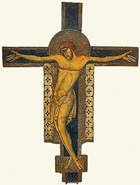
The ancient church of Santa Maria della Selva Mattutina was first documented in 1334 as the home of a dissident Franciscan community that was accused of heresy. It was documented again in 1466, when it belonged to the now-recognised Franciscan Third Order Regular (Fraticelli). The Fraticelli of San Rocco moved here in 1526, and it became the only surviving convent in Umbria belonging to this branch of the Order when Santa Caterina di Rapicchiano, near Spello and San Lorenzo di Foligno closed soon after. It seems likely that the Crucifix originally had a Franciscan provenance, and that it subsequently passed into the ownership of one of these communities of Fraticelli, perhaps those from San Rocco.
Frescoes (14th century)
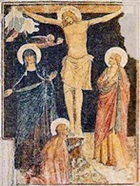
-
✴the much re-painted Crucifixion with the Virgin and St John the Evangelist, and with St Mary Magdalene kneeling at the foot of the cross (illustrated here);
-
✴St Margaret in prison; and
-
✴a very damaged and heavily repainted fresco of the Madonna and Child enthroned, which is attributed to the Maestro della Dormitio di Terni.
Crucifix (ca. 1461)
Frescoes (ca. 1471)
The frescoes, which had been painted on the semi-circular apse of Santa Maria di Turri after its restoration in 1471, were detached before the church was demolished in 1883. They had to be cut into four parts and stuck to a flat surface before their transfer to the Pinacoteca. They depict:
-
✴the Madonna and Child enthroned, with angels;
-
✴SS Peter and Stephen to the sides; and
-
✴the Crucifixion with the Virgin and St John the Evangelist, and with St Mary Magdalene kneeling at the foot of the cross.
Painted doors from a tabernacle (15th century)
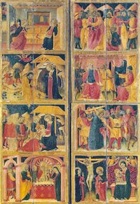
The panel, which was documented in Santa Maria di Turrita in 1829, was moved to the Duomo, Spoleto in 1837. The Commune protested vigorously, and it was returned in 1839.
Coronation of the Virgin with Saints (15th century)
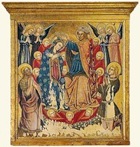
Crucifix with the Virgin and saints (15th century)
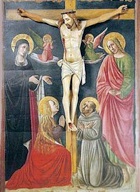
-
✴a polychrome wooden Crucifix; and
-
✴a frescoed backdrop of the Virgin, St John the Evangelist and two angels, with SS Mary Magdalene and Francis kneeling at the foot of the cross.
It was documented in the 19th century in the convent of San Fortunato. It almost certainly came from the church, but its original location there is unknown.
The attribution of the two components of the work is also uncertain:
-
✴The Crucifix has been attributed to a sculptor called Ponziano di Onofrio, on the basis of a signed statue (1484) of St Antony Abbot that Fra. Antonio da Montefalco commissioned for Santa Maria delle Grazie, Massa Martana.
-
✴The fresco is clearly by an artist from Foligno, perhaps Pietro di Giovanni Mazzaforte.
Maestà dei Bennati (15th century)


Detached frescoes Aedicule with replacement fresco (1966)
These fresco fragments came from aedicule at the junction of the road to Spoleto and Via San Fortunato (see the Walk), on land owned by the Bennati family. They were detached in 1878 and mounted on a single canvas.
-
✴The main fresco depicted the Mother and Child enthroned with two pairs of musical angels. The lower part of the fresco, which seems to have included two standing saints, no longer survives.
-
✴The three figures now mounted below, which came from the archivolt, depict SS Antony Abbot and Bernardino of Siena, with a tondo of the Agnus Dei between them.
-
✴The figures now mounted above the main scenes, which originally belonged to standing figures to the sides, depict SS Antony of Padua and Clare of Montefalco. Again, only the upper parts survive
The work is attributed to Pierantonio Mezzastris, based on its similarity to the signed Maestà Bella in an aedicule near Carpello, outside Foligno.
Madonna and Child (ca. 1470)
The panel in Montefalco is generally dated in relation to the (now lost) copy of this icon that Alessandro Sforza, lord of Pesaro commissioned from Melozzo da Forli in ca. 1470. There is some debate about its attribution:
-
✴It is usually thought, on stylistic ground, to be another copy by Melozzo da Forli or his workshop.
-
✴However, yet another copy of the icon that was in the Charles Loeser Collection, Florence until 1959 is generally attributed to Antoniazzo Romano, who was a prolific painter of this kind of image (as set out in the page on this artist). Federico Zeri attributed the panel in Montefalco to him.
-
✴Laura Teza has recently suggested, on stylistic ground, that it is by the Perugian, Bartolomeo Caporali, who was documented in Rome in 1467 among the artists working for Pope Paul II at the Chiesa di San Marco (as referenced in the page on this artist).
[The image in this Hungarian website has obvious relevance to the debate, but I have not been able to find out anything else about it.]
Three Saints (ca. 1488)
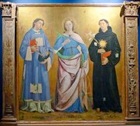
The altarpiece depicts three saints who are identified by inscription as SS Vincent of Saragossa, Illuminata and Nicholas of Tolentino. Recent restoration has shown that these inscriptions are not original and that:
-
✴the central figure of “Sant’ Illuminata” originally had a wheel (later over-painted but revealed in the restoration), and so had been adapted from an image of St Catherine of Alexandria: and
-
✴“St Nicholas of Tolentino” originally had a Franciscan habit that had been over-painted, and so had been adapted from an image of a Franciscan, probably St Antony of Padua.
This over-painting was almost certainly done at the time that the panel was transferred to Montefalco.
The presence of St Catherine of Alexandria at the centre of the composition suggests that the altarpiece was painted for an altar dedicated to her. The Portuguese Cardinal Jorge Costa, who had bought the Cappella di Santa Caterina in Santa Maria del Popolo from Cardinal Domenico della Rovere in 1488, almost certainly commissioned it: this probably accounts for the presence of two Iberian saints (SS Vincent of Saragossa and Antony of Padua). The panel was probably transferred to Montefalco after the death of Cardinal Costa in 1508.
Works by or Attributed to Francesco Melanzio
The Pinacoteca contains a number of works by or attributed to Francesco Melanzio:
Madonna and Child with saints (1487)
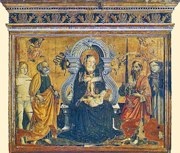
A surviving document records that Pietro Paolo di Giovanni Marino commissioned this panel from “Francesco pentore” in 1486. The inscription along the top of the frame again records Pietro Paolo di Giovanni Marino, and gives the date 1487, while the inscription at the bottom identifies the artist as Francesco Melanzio. This is his earliest known work.
Pietro Paolo di Giovanni Marino was the prior of the Confraternita di San Nicolò da Tolentino, and he commissioned this panel for the confraternity’s chapel in Sant’ Agostino. The document in which he commissioned the work prescribes that it should depict the Madonna and Child with SS Sebastian, Peter, Paul and Dominic, with other saints, including St Nicholas of Tolentino, in the predella. If the predella was ever painted, it was subsequently lost, while St Nicholas of Tolentino replaced St Dominic in the panel itself.
Madonna and Child with saints (1488)
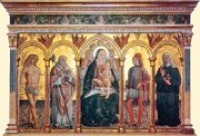
Angelo di Bartolomeo, the rector of Santa Maria di Turrita, and his associates Evangelista di Cecco and Pellegrino di Francesco commissioned this altarpiece from Francesco Melanzio in 1485, but it took some time to complete: it is dated by inscription to 1488. It depicts the Madonna and Child enthroned with SS Sebastian, Fortunatus, Severus and Clare of Montefalco.
Madonna and Child with saints (1498)

-
✴SS Antony of Padua, Bernardino of Siena, Francis on the left; and
-
✴SS Fortunatus, Louis of Toulouse and Severus on the right.
It was originally used as a processional banner, and was probably commissioned during an outbreak of plague. St Fortunatus holds a model of Montefalco and the staff that he used to use to drive his oxen, which burst into leaf when he died.
Detached frescoes (ca. 1500)

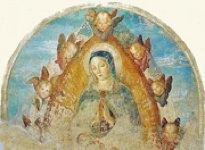

These damaged fresco fragments, which were detached in 1877 from a tabernacle outside San Fortunato, are attributed to Francesco Melanzio. They comprise:
-
✴a figure of St Francis;
-
✴the Madonna and Child enthroned; and
-
✴tondi of the Annunciation.
Madonna del Soccorso (1504)
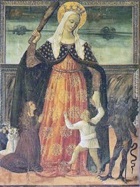
The surviving inscription along the top of the frame identifies the subject as the Madonna del Soccorso (of Succour). As is usual in this iconography, the Virgin clubs a devil that tries to possess a child. A female supplicant (presumably the mother) kneels under the Virgin's protective cloak.
Madonna and Child with musical angels (1510)

Coronation of the Virgin (early 16th century)
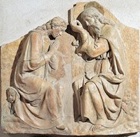
Madonna and Child with saints (1602)
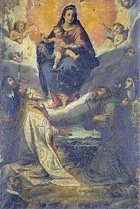
The composition of the panel is based on that of Raphael’s Madonna di Foligno (1511-2), which was at this time on the high altar of Sant’ Anna, the church of a Franciscan nunnery in Foligno.
Madonna and Child with saints (1605)
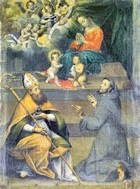
The panel depicts the Madonna and Child with the young St John the Baptist and SS Nicholas of Bari and Francis. It is attributed to Simeone Ciburri.
Assumption of St Mary Magdalene (ca. 1732)
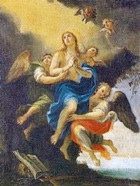
Assumption of the Virgin (18th century)
This altarpiece by Antonio Maria Garbi is from San Filippo Neri and probably passed into the civic collection when this church was adapted to house the collection in 1871. It is a faithful copy of an altarpiece (1637) by Guido Reni from San Filippo Neri, Perugia, which is now in the Musée des Beaux Arts, Lyon.

_files/shapeimage_2_link_0.png)
_files/shapeimage_2_link_1.png)
_files/shapeimage_2_link_2.png)
